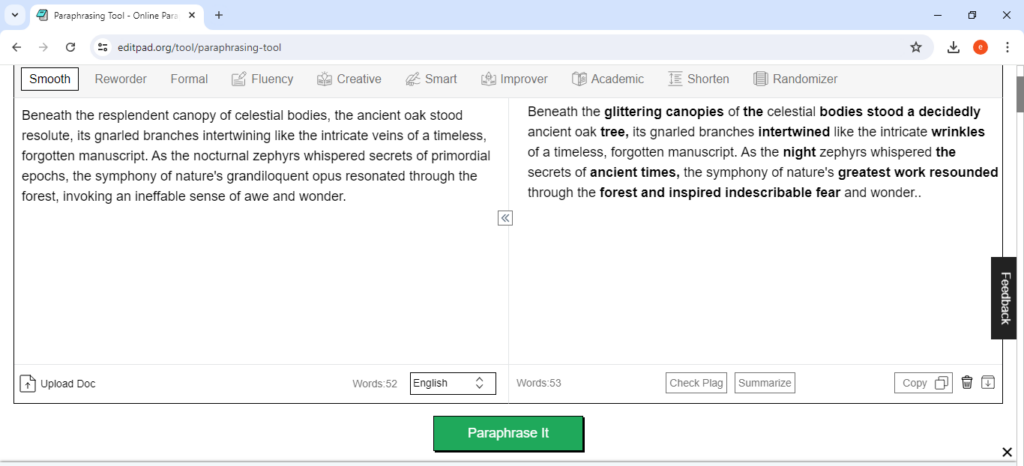How to Paraphrase Like a Pro
Paraphrasing is a technique used to add clarity to something written or spoken. The purpose of paraphrasing is to achieve greater understanding and precision in the written or spoken content. It is usually done by using a different set of words. It is taken care that the original meaning and intent of the content remain intact.
In manual paraphrasing, a person uses different techniques to change the presentation of the content. It is a comprehensive way of paraphrasing content that involves a lot of methods. Some paraphrasing methods are discussed below:
Methods of Manual Paraphrasing
1. Using Synonyms
Synonyms are different sets of words with similar meanings. Alternate words replace the original words of the content and don’t let the intent go away. This method consists of changes in sentence structure and vocabulary. It is used to explain the intent of the content to the targeted audience. It can be explained with a simple example:
Original: “An old man hastily ascended the abrupt slope.”
Paraphrased: An old man quickly climbed the slope.
It is clear from the example that paraphrased sentence can easily be understood by a school-going even.
2. Changing The Active To Passive Voice
Changing the passive voice to the active voice is another method of paraphrasing the content manually. This method is often used to emphasize the doer instead of the work being done in a situation. Another purpose is completely opposite i.e. changing the active voice to passive voice, as it is used to deemphasize the doer. It can be seen in the following example:
Original: “The chef cooked a delicious meal.”
Paraphrased: A delicious meal was cooked by the chef.
An example of deemphasizing the doer:
“The window was broken.”
3. Changing The Word Order
It is a method in which the arrangement of words or sentence structure is changed. The purpose is to clarify the intent while keeping the meaning unchanged. The position of words or clauses is changed. The following example elaborates on it:
Original: “I lost the wedding ring when I was walking.”
Paraphrased: During the walk, I lost the wedding ring.
4. Removal Of Unnecessary Words
In this method, unnecessary, irrelevant, and repetitive words are removed. This paraphrasing technique makes the message in the content concise. The content, after the removal of unnecessary words, becomes engaging, impactful, and professional. For instance:
Original: “The reason for his absence from the party was because he was feeling sick.”
Paraphrased: He didn’t come to the party because he was feeling sick.
These manual paraphrasing methods are effective, efficient, and accurate. However, they are time-consuming and difficult. Also, they require sufficient knowledge of English grammar and vocabulary.
There is another method to paraphrase the content flawlessly. It is mentioned below:
5. Using A Tool
Paraphrasing can also be done using an online tool which requires less time and effort. We just need to paste or type the content in the tool. With a single click, it paraphrases the content within no time.
The tool uses combinations of methods used in manual paraphrasing. It changes the sentence structure, and vocabulary, and removes unnecessary words. These combinations improve the clarity, engagement, conciseness, and flow of the content.
Various online tools offer limited (free-of-cost) and unlimited (paid) paraphrasing services. Let’s test the working of an online tool and see the results.
The Real Test Of A Paraphrasing Tool
We will be using a random online tool ranking high for paraphrase tool free in the SERPs. We will give it a paragraph and check its efficiency. This tool offers many other paid services too, like AI writing, summarizing, and extracting text from images. But we will just be using its free paraphrasing service for limited words.
Result
Below is a picture of Editpad’s interface. On the left, there is an input paragraph, and a paraphrased paragraph (output) is on the right.

We can see in the picture that Editpad used synonyms to paraphrase and made the paragraph smooth and easy to read. The fluency increased in the sentences.
Conclusion
There are different methods of paraphrasing written content. These methods involve manual editing techniques: changing the sentence structure, changing active voice to passive voice, using synonyms, and removing unnecessary words. However, they can cost plenty of time and extensive effort. But, using a paraphrasing tool, the same can be done effortlessly.





